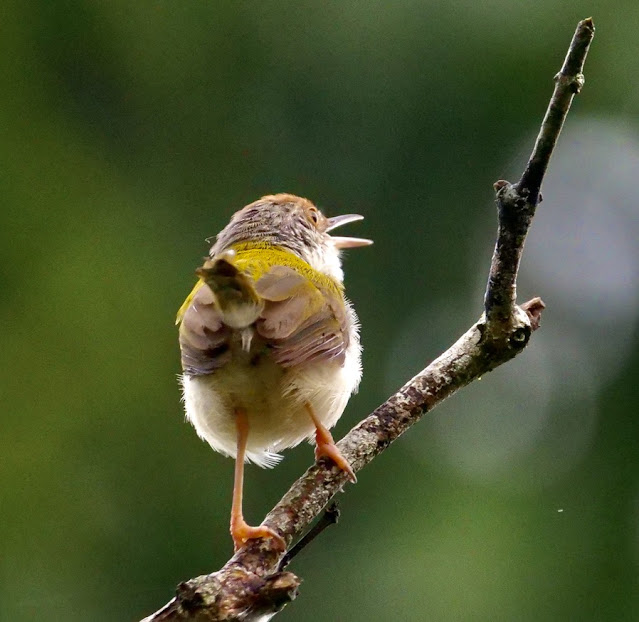During the time this common Tailor bird was perched in this branch, I kept watching its body movements and listened to tis bird calls.
It turned to its left side occasionally. Most of its neck direction was towards the right side, upward and backward.
The bird calls were infrequent unlike its continuous singing, when they are stationary. It is not common for it to be in one static position; it just shifts between twigs and covers under foliage. So it was strange to see this bird perched open to the sky and giving away its bird calls only occasionally.

A tailor bird has its habits and patterns. Its names is derived from one of its habits. It weaves the leaves of tress by stitching them together with fibres or thread to make its nest. It would look like a hollow covered with leaves and thread acting like a bridge between the leaves. It normally moves between trees which are low in height and are hidden behind the leaves. They move between twigs and fly out to the next flight station. These and other habits are common to all the Tailorbirds.
I have thought about the habits and patterns of infants and toddlers. When a mother carries her baby on the arms after he or she is born, a well baby would search for mother's breast. A baby cries when hungry, wet, anxious or cold! After the feed most infants would have a short nap and lay quiet for a while and cry for receiving attention. When carried, the baby is consoled. When played with or cuddled, a baby feels comfortable and becomes responsive to take turns. One can play peek-a-boo with a four months old baby to receive the initial responses. An infant uses both hands to reach out to receive a toy between four and six months, make sounds and would crawl by nine months. From then on, the development of different functions take place in succession expected for that chronological age. These are genetically coded and takes place inherently.
But the behaviour of an infant or a toddler is conditioned by the environment. A baby who receives the input of being called, played with, sung to, read to, shown pictures, and given toys to explore responds to these stimuli and initiatives. It is what we do which creates a behavioural response. An infant communicates by tracking objects with eyes, reciprocating to sounds, reaching kneeling position seeing a doll placed on the chair, reaching out hands to receive toys, crawling when a moving ball is spotted, kneeling to pick up a doll placed on a chair; picking up food placed before the child with hands, learning to wave while seeing off children, etc.
Instead, if an infant or toddler is placed before the TV screen with cartoons, animations with music, or shown car race on a mobile, the child gets conditioned to be quiet. As these activities on the screen do not need a response, a child is conditioned to be passive. The sounds from the screen do not have an emotional tone or a facial gesture to associate with the sounds. A child who can normally hear at 15 to 20 dBs often listens to the screen sounds at 60 or more dBs. This exposure to loud sounds, conditions child to ignore any sounds produced at a lower decibel level. The human conversational decibel level would be around 40dBs.
One unfortunate outcome of this early exposure to the visual media is the conditioning, taking place to see, hear and engage in sights, sounds and scenes which are artificial. This not countered with activities where an infant or a toddler would need to respond to human voices or interactive activities.
I have had stories of infants and toddlers watching programme in the visual media for eight or more hours in a day, which means most of the wakeful times of a child is spent with the visual media.
I remember in the month of February 2023, out of ten children between 18 and 36 months of age, whom I welcomed when parents came with concerns about the child not using expressive language, eight of them had a history of having been exposed to the visual media from the age of nine months. Usually an infant is able to sit with steady head and trunk by nine months. From then on many infants are made to watch the visual media in order that parents can be free, when their child is occupied! This practice began with many families, when parents worked from home during the COVID pandemic season.
We created a generation of infants and toddlers, who are visual media dependent and many of these children are on developmental therapy to promote their language skills, communication, attention and preschool learning intent. They are denied regard pr-schooling experiences.
The confession of a parent couple disturbed me most: 'When ever we try to engage our daughter, who is three years, she cries till the TV is put on. We cannot get her to play or communicate'. This child who was taken care of by grandparents got introduced to the TV viewing from the time she got up in the morning from the age of nine months.
All infants and toddlers are coded to pass through their developmental sequences of physical development, social skills, language and communication skills, pre-school skills, et. But when we interfere with that process by interrupting them with visual media exposure, we disrupt the normal developmental process.
The sound parenting practices have got displaced by technological invasion of our homes, where the visual media has become the surrogate parents!
Th loss of childhood we impose on infants and toddlers is a big loss to them and a heavy burden to parents later in life!
We can impact the developmental and educational trajectory of infants and toddlers, by following sound parenting practices!
M.C.Mathew (text and photo)









No comments:
Post a Comment